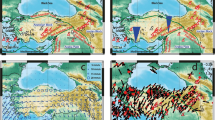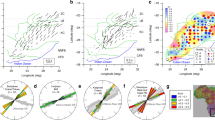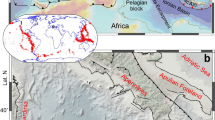Abstract
The orientation and depth of deformation in the Earth is characterized by seismic anisotropy1—variations in the speed of passing waves caused by the alignment of minerals under strain into a preferred orientation. Seismic anisotropy in the western US has been well studied2,3,4,5,6,7,8,9,10,11 and anisotropy in the asthenosphere is thought to be controlled by plate motions and subduction6,7,8,9. However, anisotropy within the crust and upper mantle and the variation of anisotropy with depth are poorly constrained. Here, we present a three-dimensional model of crustal and upper mantle anisotropy based on new observations of ambient noise12 and earthquake13 data that reconciles surface wave and body wave9 data sets. We confirm that anisotropy in the asthenosphere reflects a mantle flow field controlled by a combination of North American plate motion and the subduction of the Juan de Fuca and Farallon slab systems6,7,8,9. We also find that seismic anisotropy in the upper mantle and crust are largely uncorrelated: patterns of anisotropy in the crust correlate with geological provinces, whereas anisotropy in the upper mantle is controlled by temperature variations. We conclude that any coupling between anisotropy in the crust and mantle must be extremely complex and variable.
This is a preview of subscription content, access via your institution
Access options
Subscribe to this journal
Receive 12 print issues and online access
$259.00 per year
only $21.58 per issue
Buy this article
- Purchase on Springer Link
- Instant access to full article PDF
Prices may be subject to local taxes which are calculated during checkout




Similar content being viewed by others
References
Savage, M. K. Seismic anisotropy and mantle deformation: What have we learned from shear wave splitting? Rev. Geophys. 37, 65–106 (1999).
Ozalaybey, S. & Savage, M. K. Shear-wave splitting beneath western United States in relation to plate tectonics. J. Geophys. Res. 100, 18135–18149 (1995).
Savage, M. K. & Sheehan, A. F. Seismic anisotropy and mantle flow from the Great Basin to the Great Plains, western United States. J. Geophys. Res. 105, 13715–13734 (2000).
Silver, P. & Holt, W. The mantle flow field beneath western North America. Science 295, 1054–1057 (2002).
Savage, M. K. Seismic anisotropy and mantle deformation in the western United States and southwestern Canada. Int. Geol. Rev. 44, 913–937 (2002).
Becker, T. W., Schulte-Pelkum, V., Blackman, D. K., Kellogg, J. B. & O’Connell, R. J. Mantle flow under the western United States from shear wave splitting. Earth Planet. Sci. Lett. 247, 235–251 (2006).
Marone, F. & Romanowicz, B. The depth distribution of azimuthal anisotropy in the continental upper mantle. Nature 447, 198–201 (2007).
Zandt, G. & Humphreys, E. Toroidal mantle flow through the western US slab window. Geology 36, 295–298 (2008).
West, J. D., Fouch, M. J., Roth, J. B. & Elkins-Tanton, L. T. Vertical mantle flow associated with a lithospheric drip beneath the Great Basin. Nature Geosci. 2, 438–443 (2009).
Moschetti, M. P., Ritzwoller, M. H., Lin, F. & Yang, Y. Seismic evidence for widespread western-US deep-crustal deformation caused by extension. Nature 464, 885–889 (2010).
Buehler, J. S. & Shearer, P. M. Pn tomography of the western United States using USArray. J. Geophys. Res. 115, B09315 (2010).
Lin, F., Moschetti, M. P. & Ritzwoller, M. H. Surface wave tomography of the western United States from ambient seismic noise: Rayleigh and Love wave phase velocity maps. Geophys. J. Int. 173, 281–298 (2008).
Yang, Y., Ritzwoller, M. H., Lin, F., Moschetti, M. P. & Shapiro, N. M. Structure of the crust and uppermost mantle beneath the western United States revealed by ambient noise and earthquake tomography. J. Geophys. Res. 113, B12310 (2008).
Sabra, K. G., Gerstoft, P., Roux, P., Kuperman, W. A. & Fehler, M. C. Surface wave tomography from microseisms in Southern California. Geophys. Res. Lett. 32, L14311 (2005).
Shapiro, N. M., Campillo, M., Stehly, L. & Ritzwoller, M. H. High-resolution surface-wave tomography from ambient seismic noise. Science 307, 1615–1618 (2005).
Pollitz, F. F. Observations and interpretation of fundamental mode Rayleigh wavefields recorded by the Transportable Array (USArray). J. Geophys. Res. 113, B10311 (2008).
Lin, F., Ritzwoller, M. H. & Snieder, R. Eikonal tomography: Surface wave tomography by phase front tracking across a regional broad-band seismic array. Geophys. J. Int. 177, 1091–1110 (2009).
Bensen, G. D. et al. Processing seismic ambient noise data to obtain reliable broad-band surface wave dispersion measurements. Geophys. J. Int. 169, 1239–1260 (2007).
Smith, M. L. & Dahlen, F. A. Azimuthal dependence of Love and Rayleigh-wave propagation in a slightly anisotropic medium. J. Geophys. Res. 78, 3321–3333 (1973).
Barruol, G. & Kern, H. Seismic anisotropy and shear-wave splitting in lower-crustal and upper-mantle rocks from the Ivrea zone—experimental and calculated data. Phys. Earth Planet. Inter. 95, 175–194 (1996).
Montagner, J-P. & Nataf, H-C. A simple method for inverting the azimuthal anisotropy of surface waves. J. Geophys. Res. 91, 511–520 (1986).
Rumpker, G. & Silver, P. G. Apparent shear-wave splitting parameters in the presence of vertically varying anisotropy. Geophys. J. Int. 135, 790–800 (1998).
Montagner, J-P., Griot-Pommera, D-A. & Lavé, J. How to relate body wave and surface wave anisotropy? J. Geophys. Res. 105, 19015–19027 (2000).
Gripp, A. E. & Gordon, R. G. Young tracks of hotspots and current plate velocities. Geophys. J. Int. 150, 321–361 (2002).
Zhang, S. Q. & Karato, S. Lattice preferred orientation of olivine aggregates deformed in simple shear. Nature 375, 774–777 (1995).
Holt, W. E. Correlated crust and mantle strain fields in Tibet. Geology 28, 67–70 (2000).
Acknowledgements
Instruments [data] used in this study were made available through EarthScope (http://www.earthscope.org; EAR-0323309), supported by the National Science Foundation. The facilities of the IRIS Data Management System, and specifically the IRIS Data Management Center, were used for access to waveform and metadata required in this study. The IRIS DMS is funded through the National Science Foundation and specifically the GEO Directorate through the Instrumentation and Facilities Program of the National Science Foundation under Cooperative Agreement EAR-0552316. This work has been supported by NSF grants EAR-0711526 and EAR-0844097.
Author information
Authors and Affiliations
Contributions
F-C.L. carried out ambient noise and earthquake tomography for the Rayleigh-wave measurements, computed the three-dimensional inversion and co-wrote the paper. M.H.R. guided the study and co-wrote the paper. Y.Y. and M.P.M contributed surface-wave analysis tools. M.J.F. assembled and carried out SKS splitting measurements. All authors discussed the results and provided comments on the manuscript.
Corresponding author
Ethics declarations
Competing interests
The authors declare no competing financial interests.
Supplementary information
Supplementary Information
Supplementary Information (PDF 2546 kb)
Rights and permissions
About this article
Cite this article
Lin, FC., Ritzwoller, M., Yang, Y. et al. Complex and variable crustal and uppermost mantle seismic anisotropy in the western United States. Nature Geosci 4, 55–61 (2011). https://doi.org/10.1038/ngeo1036
Received:
Accepted:
Published:
Issue Date:
DOI: https://doi.org/10.1038/ngeo1036
This article is cited by
-
Crust-mantle decoupling beneath Afar revealed by Rayleigh-wave tomography
Scientific Reports (2022)
-
3-D Upper-Mantle Shear Velocity Model Beneath the Contiguous United States Based on Broadband Surface Wave from Ambient Seismic Noise
Pure and Applied Geophysics (2018)
-
Crustal azimuthal anisotropy in the trans-North China orogen and adjacent regions from receiver functions
Science China Earth Sciences (2018)
-
Seismic Tomography of the Southern California Plate Boundary Region from Noise-Based Rayleigh and Love Waves
Pure and Applied Geophysics (2015)
-
A method for inversion of layered shear wavespeed azimuthal anisotropy from Rayleigh wave dispersion using the Neighborhood Algorithm
Earthquake Science (2015)



